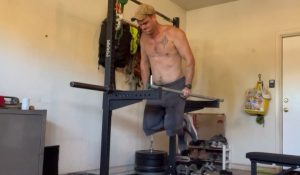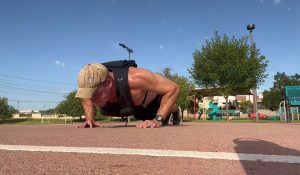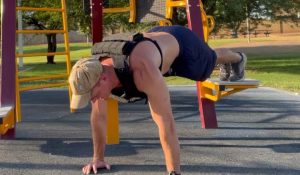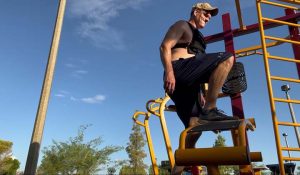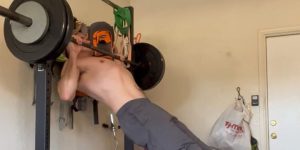After years of experimentation, I’ve tried it all when it comes to basic bodyweight programs on a time budget. One model that I often come back to when I’m trying to progress on simple calisthenic exercises like push-ups, pull-ups, and squats is the the “heavy, light, medium” calisthenics method.
If you’re unaware of the heavy, light, medium model:
What is a heavy, light, medium program?
Heavy, light, medium is a model of structuring weekly strength training routines by training similar lifts in different intensity ranges. Rather than focusing on body parts like a body part split or upper / lower program, we train the entire body on each training day, but with a different focus each day.
- Monday (heavy day): Since we’re the most rested on Monday, this day is reserved for heavy strength-focused lifts
- Wednesday (light day): The accumulated fatigue of Monday’s workout will necessitate that Wednesday will be trained in lower intensity range in order to drive progress while facilitating recovery
- Friday (medium day): Since Wednesday’s “light” workout left us feeling recovered and fresh, we’ll tackle weights on Friday that are somewhere between Monday’s and Wednesday’s
This method of training was originally developed by strength and conditioning legend Bill Starr for his football players, and is continued on to this day by well respected coaches like Andy Baker. It’s designed to be performed three days per week, with two rest days prior to the heavy day.
This style of training plan is most often applied to intermediate lifters: trainees who are no longer making progress workout-to-workout. If you’ve stalled out after following a linear model for a while, then this plan is sure to reignite your efforts to build muscle.
How to apply heavy, light, medium to bodyweight exercises
When I’m doing heavy, light, medium bodyweight programs, I focus on picking variations of lifts that fall into the category of heavy, light, or medium for each movement pattern: one each for pressing, pulling, and legs.
Here’s how I typically structure things.
Monday: Heavy day
- Dips: 5 sets within 1-2 reps of muscular failure
- Pull-ups: 5 sets within 1-2 reps of muscular failure
- Bulgarian split squats: 5 sets within 1-2 reps of muscular failure (start with your weaker leg, then match reps with the stronger leg)
On Monday, our focus is performing “heavy” versions of basic calisthenics, going very close to failure, and performing lots of sets. This session should leave you feeling taxed.
On this day, rest 2-4 minutes between sets of each exercise so you’re fully recovered for each set. We are also hammering the muscles hard by performing five sets per exercise.
Wednesday: Light day
- Regular push-ups: 3 sets within 3-4 reps of muscular failure
- Inverted rows: 3 sets within 3-4 reps of muscular failure
- Squats: 2 sets of AMRAP in 2 minutes, resting 2 minutes between sets
On Wednesday, we perform “light” variations of basic bodyweight exercises, with only a few sets per exercise. Move fairly quickly and stay away from failure. You should leave this session feeling refreshed and recovered.
On this day, rest 1-2 minutes between sets. Since we won’t be fully recovering between sets, they will accumulate fatigue over the course of the workout, but this day should feel easy. Since we’re likely still a bit sore or fatigued from Monday’s workout, we’ll be performing only three sets per exercise, then leaving the gym.
Friday: Medium day
- Decline push-ups: 4 sets within 2-3 reps of muscular failure
- Chin-ups: 4 sets within 2-3 reps of muscular failure
- Walking lunges (or reverse lunges): 3 sets of AMRAP in 2 minutes, resting 3 minutes between sets.
On Friday, we’re using variations of exercises that are heavier than Wednesday, but lighter than Monday. The overall volume (number of sets performed) is also between Monday and Wednesday. Hence, the name “medium day.”
I would recommend resting 2-3 minutes between sets on this day. Your next order of business will be to get appropriate rest for the weekend.
This is where the beauty of this program lies – you accumulate stress during the week, and use the weekend to recover and get stronger.

Substituting exercises or changing the order
You are welcome to substitute the exercises above for others, as long as they are compound exercises that serve the same purpose. For instance, if you wish to grow your triceps specifically, use diamond push-ups instead of normal push-ups.
Or, if you’re looking to grow your hamstrings relative to your quads, opt for very long-step reverse lunges on Friday and take a similar long-stance for your split squats on Monday. If you’re looking to grow your quads, do the opposite: make the steps short and opt for walking lunges instead.
Similarly, if you’re looking for one part of your body to grow relative to another, then perform that exercise first. For instance, if your back is weak, then start the workout with your upper body pulling exercise instead of your pressing exercise.
How to make the workouts quick
It’s likely that you’ve chosen bodyweight exercises because you’re on a tight time budget. If this describes you, then here are a couple simple ways to make the workouts very quick.
I love doing these workouts in this fashion because they allow me to get a quick training session done, with plenty of time leftover for a quick one or two mile jog or burpee pyramid finisher at the end.
Option 1: Use supersets
The first, and most obvious way to speed up this workout is to perform a simple chest and back antagonistic superset. This technique involves pairing the press and pull exercise for the day back-to-back and it will cut your workout time down by about 30%.
If you choose to do it this way, cut the recommended rest time in half. As an example, on your heavy day, instead of resting 4 minutes between sets, you would perform:
- Dips @ 1-2 RIR
- 2 minutes rest
- Pull-ups @ 1-2 RIR
- 2 minutes rest
- Repeat for 5 rounds
This will ensure that by the time you return to dips, you will have rested around four minutes.
Option 2: Perform the exercises as a circuit
I’ve not been shy about the fact that circuits are likely my favorite way to train these days. If you’re trying to save time, this is the way to go.
If you plan on performing the exercises as a circuit, then I would divide the rest time in thirds. An example, on your heavy day you would:
- Dips @ 1-2 RIR
- 1 minute rest
- Pull-ups @ 1-2 RIR
- 1 minute rest
- Bulgarian split squats @ 1-2 RIR
This will ensure that you’ve rested a certain body part for around four minutes before returning to work it again.
How to address weak points

One of the drawbacks of full-body training in general is that it’s much tougher to address weak points in the physique than it would be on something like a push, pull, legs bodyweight routine.
However, this is easily addressed:
A simple modification we can make to this program if you’ve got a definite physique weakness that you wish to address is to add a single set of myo reps for an isolation exercise.
For instance, if your biceps are lagging, you could complete your main three exercises, and then finish with a myo rep set of bodyweight bicep curls on Monday and Friday.
Some common weak points, and ways to address them:
- For lagging upper chest, perform myo reps of a TRX chest flye
- For lagging rear delts, perform myo reps of a TRX face pull or band face pull.
- For lagging biceps, perform bodyweight preacher curls
- For lagging calves, perform bodyweight calf raises (one leg at a time!)
I would NOT recommend trying to address more than one weak point at a time on this program. If you’ve got a weak point, pick ONE exercise to perform after your main sets on Monday and Friday ONLY.
I say this because if you add too much extra fluff into your workout, you will make the workout unnecessarily long and risk compromising your recovery ability.
Add weight to your heavy, light, medium calisthenics program
If you’ve been on the program for a while and are regularly achieving sets of over 8-10 on your Monday lifts, then a simple way to address this would be with the addition of a weighted vest. Adding weight to simple bodyweight training basics is a surefire way to improve progress over the long haul.
I would recommend using a vest with easily adjustable weights, like a V-Max weighted vest or something similar. This will allow you to regulate the repetitions down into an appropriate range (Under 10 per set) and continue to adjust the weight over time.
Good luck, and happy lifting!













